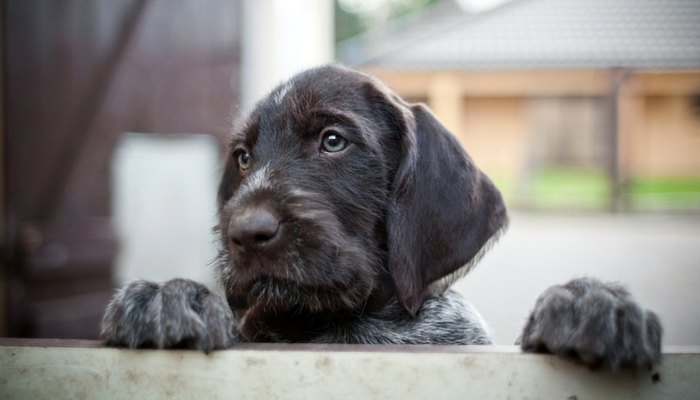Separation anxiousness is a reasonably widespread behavioral difficulty in canine, and positively figuring out the difficulty is step one it’s good to take in terms of managing it. Under we’ll go over the widespread signs of separation anxiousness, and a few assets that will help you handle it.
And earlier than we start it’s necessary to know you’re not alone, and it’s not essentially brought on by one thing you probably did unsuitable, practically 80% of canine discover it worrying to be left alone.
From extreme barking if you’re away to overly excited greetings on the door, right here’s 10 widespread signs of separation anxiousness in canine.
Barking & Howling
One of the apparent indicators of canine separation anxiousness is a canine that barks or howls if you go away. They might sit on the window and howl, or they might bark whereas left of their crate. The one factor this type of barking has in widespread is that it’s persistent, and it’s instantly triggered by being left alone.
Pacing
Pacing is one other widespread symptom of separation anxiousness. Some canine might tempo forwards and backwards close to the door, whereas others might tempo in particular patterns all through the home. If it’s being brought on by separation anxiousness the habits is just current when their proprietor is gone.
Urinating & Defecating
Some canine could have accidents in the home when stressed, and this consists of anxiousness brought on by being alone. In case your canine is potty educated and solely appears to have accidents if you’re away it’s doubtless instantly resulting from separation anxiousness.
Salivating & Panting
Additional salivating and panting may be indicators of nervousness and anxiousness, and a few canine with separation anxiousness will exhibit these behaviors.
Restlessness When Left Alone
A normal restlessness if you go away is one other signal your canine have separation anxiousness. In the event that they’re consistently getting up, checking the home windows, and seemingly unable to loosen up or nap likelihood is they’re anxious.
Attempting to Escape
In extreme circumstances of separation anxiousness canine will attempt to escape from wherever they’re confined to, whether or not that’s their crate or the home itself. They might chew by means of doorways or probably break home windows, which may end up in critical accidents.
Damaging Behaviors (Chewing & Digging)
When left alone some canine exhibit damaging behaviors, akin to chewing on furnishings or the partitions. In the event that they solely interact in these type of behaviors when left alone it’s doubtless resulting from separation anxiousness.
Clingy Habits
In case your canine refuses to depart your aspect if you come dwelling they may have separation anxiousness. Now a clingy canine isn’t at all times one with separation anxiousness, but when your canine solely sticks proper by your aspect after you come dwelling it’s doubtless as a result of they’re nonetheless making an attempt to recover from the anxiousness they felt if you have been gone.
Nervousness and/or Pleasure When You’re Leaving
Canine are good, they usually know our routines simply in addition to us. In case your canine begins to get nervous within the morning if you’re preparing for work they’re exhibiting indicators of separation anxiousness. That ritual of preparing is inflicting them anxiousness since they know they’re going to be left alone.
Overly Excited Greetings When You Get House
All of us love coming dwelling to a cheerful canine, however overly excited greetings generally is a slight trigger for concern. In case your canine will get so excited they pee, or if they will’t include themselves and begin to tremble if you come again dwelling they may have separation anxiousness.
What to Do If Your Canine Has Separation Anxiousness
Now that we’ve lined the signs of separation anxiousness it’s time to provide you with a administration plan.
Sadly it received’t be cured in a single day and it’s not one thing your canine will simply outgrow with time, however there are some easy steps you may to do assist handle the habits (so long as it’s not a extreme case akin to escaping by means of home windows, at which level you must attain out to a coach for assist).
I’ve written an whole article about how you can handle your canine’s separation anxiousness, however right here’s the TLDR model to assist get you began;
- Step 1: Maintain your canine calm as you prepare. If you understand brushing your tooth begins to get them riled up give them a deal with whilst you brush to try to flip that a part of your routine right into a optimistic one for them.
- Step 2: Get your canine used to you leaving. Go away for brief durations of time to get your canine used to you leaving, quite than them simply stressing about you solely leaving for 8+ hours at a time.
- Step 3: Give your canine one thing to do if you go away. Frozen kongs (a toy crammed with frozen canine treats) is my favourite for this; it offers your canine one thing enjoyable and productive to do, and because it’s drozen it ought to final a superb whereas.
- Step 4: Educate your canine impartial behaviors. By encouraging your canine to do issues on their very own at a distance from you, you may train them that they don’t should be proper at your aspect to be snug.
- Step 5: Maintain your canine bodily & mentally exercised. When you maintain your canine bodily and mentally exercised every day they’re more likely to stay calm and nicely behaved if you’re away. There’s loads of methods to maintain your canine busy indoors, and a few methods to assist tire them out.
Extra Assets For Managing Separation Anxiousness
Sadly there isn’t any magic in a single day remedy for separation anxiousness, however over time in the event you stick to these strategies it may be managed.

Please share with your mates
